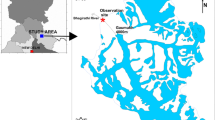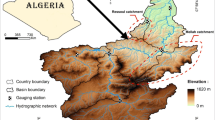Abstract
A simple technique for prediction of suspended sediment concentration (SSC) or total suspended matter in the Himalayan Bhagirathi river is presented. Artificial neural network models have been developed using short time period data of discharge (Q) and SSC during the high activity monsoon period of June to October 2004, when variations are maximum. Two modeling approaches have been employed, a daily approach and a three hourly approach. Although the time period considered is the same in both the approaches, the modeling performance is marginally better in the three hourly approaches where there is a sixfold increase in the data set. The Levenberg–Marquardt optimization algorithm has been improved with NARX [nonlinear autoregressive with exogenous input] architecture and high values of coefficient of determination have been obtained [0.89–0.97]. This study shows that short duration time series data can be used for successfully predicting geo-hydrological variables in the highly complex Himalayan river scenario.




Similar content being viewed by others
References
Abrahart RJ, White SM (2001) Modeling sediment transfer in Malawi: comparing backpropagation neural network solutions against a multiple linear regression benchmark using small data sets. Phys Chem Earth B 26(1):19–24
Alternate Hydro Energy Center Report (2011) Assessment of cumulative impact of hydropower projects in Bhagirathi and Alaknanda Basins
ASCE Task Committee on Application of the Artificial Neural Networks in Hydrology (2000a) Artificial neural networks in hydrology I: preliminary concepts. J Hydraul Eng ASCE 5(2):115–123
ASCE Task Committee on Application of The Artificial Neural Networks in Hydrology (2000b) Artificial neural networks in hydrology II: hydrologic applications. J Hydraul Eng ASCE 5(2):124–137
Bickle JM, Bunbury J, Chapman JH, Harris BWN, Fairchild JI, Ahmad T (2003) Fluxes of Sr into the headwaters of the Ganges. Geochim Cosmochim Acta 67(14):2567–2584
Boukhrissa ZA, Khanchoul K, Le Bissonnais Y, Tourki M (2013) Prediction of sediment load by sediment rating curve and neural network (ANN) in El Kebir catchment, Algeria. J Earth Syst Sci 122(5):1303–1312
Chakrapani GJ (2005) Major and trace element geochemistry in upper Ganga river in the Himalayas. India. Environ Geol 48(2):189–201
Chakrapani GJ, Saini RK (2009) Temporal and spatial variations in water discharge and sediment load in the Alaknanda and Bhagirathi rivers in Himalaya, India. J Asian Earth Sci 35:545–553
Cigizoglu HK, Kisi O (2006) Methods to improve the neural network performance in suspended sediment estimation. J Hydrol 317(3–4):221–238
Hasnain SI, Thayyen RJ (1999) Discharge and suspended sediment concentration of meltwaters, draining from the Dokriani glacier_Bamak, Garhwal Himalaya. India. J Hydrol 218(3–4):191–198
Hassoun MH (1995) Fundamentals of artificial neural networks. The MIT Press, Cambridge
Hertz J, Krogh A, Palmer RD (1991) Introduction to the theory of neural computation. Addison-Wesley, Boston
Hewitt K (1998) Catastrophic landslides and their effects on the upper Indus streams, Karakoram Himalaya, northern Pakistan. Geomorphology 26:47–80
Isazadeh M, Biazar SM, Ashrafzadeh A (2017) Support vector machines and feed-forward neural networks for spatial modeling of groundwater qualitative parameters. Environ Earth Sci 76(17):610
Iyer MS, Rhinehart RR (1999) A method to determine the required number of neural network training repetitions. IEEE Trans Neural Netw 10:427–432
Kale VS (2003) Geomorphic effects of monsoon floods on Indian rivers. In: Flood problem and management in south asia Springer, Dordrecht pp 65–84
Khan MYA, Hasan F, Panwar S, Chakrapani GJ (2016a) Neural network model for discharge and water-level prediction for Ramganga River catchment of Ganga Basin, India. Hydrol Sci J 61(11):2084–2095
Khan MYA, Chakrapani GJ (2016b) Particle size characteristics of Ramganga catchment area of Ganga River. In: Geostatistical and geospatial approachesfor the characterization of natural resources in the environment Springer, Cham, pp 307–312
Khan MYA, Hasan F, Tian F (2019a) Estimation of suspended sediment load using three neural network algorithms in Ramganga River catchment of Ganga Basin, India. Sustain Water Resour Manag 5:1115–1131
Khan MYA, Tian F, Hasan F, Chakrapani GJ (2019b) Artificial neural network simulation for prediction of suspended sediment concentration in the River Ramganga, Ganges Basin, India. Int J Sediment Res 34(2):95–107
Kisi O, Yuksel I, Dogan E (2008) Modelling daily suspended sediment of rivers in Turkey using several data-driven techniques/Modélisation de la charge journalière en matières en suspension dans des rivièresturques à l’aide de plusieurs techniques empiriques. Hydrol Sci J 53(6):1270–1285
Maier HR, Dandy GC (2000) Neural networks for the prediction and forecasting of water resources variables: a review of modelling issues and application. Environ Model Softw 15:101–124
Minns AW, Hall MJ (1996) Artificial neural networks as rainfall runoff models. Hydrol Sci J 41(3):399–417
Nagy HM, Watanabe K, Hirano M (2002) Prediction of sediment load concentration in rivers using artificial neural network model. J Hydraul Eng 128(6):588–595
Panwar S, Khan MYA, Chakrapani GJ (2016) Grain size characteristics and provenance determination of sediment and dissolved load of Alaknanda River, Garhwal Himalaya. India. Environ Earth Sci 75(2):91
Park YR, Murray TJ, Chung C (1993) Predicting sun spots using a layered perceptron neural network. IEEE Trans Neural Netw 7:501–505
Rai RK, Mathur BS (2008) Event-based sediment yield modeling using artificial neural network. Water Resour Manag 22:423–441
Rajaee T, Nourani V, Zounemat-Kermani M, Kisi O (2010) River suspended sediment load prediction: application of ANN and wavelet conjunction model. J Hydrol Eng 16(8):613–627
Rajurkara MP, Kothyari UC, Chaube UC (2004) Modeling of the daily rainfall-runoff relationship with artificial neural network. J Hydrol 285:96–113
Shamseldin AY (1997) Application of a neural network technique to rainfall runoff modeling. J Hydrol 199:272–294
Sinnakaudan SK, Ghani AA, Ahmad MSS, Zakaria NA (2006) Multiple linear regression model for total bed material load prediction. J Hydraul Eng ASCE 132(5):521
Smith J, Eli RN (1995) Neural network models of rainfall runoff process. J Water Resour Plan Manag ASCE 121(6):499–508
Tokar AS, Johnson PA (1999) Rainfall-runoff modeling using artificial neural networks. J Hydrol Eng ASCE 4(3):232–239
Valdiya KS (1998) Dynamics of Himalaya. Universities Press, Hyderabad
Yadav SK, Chakrapani GJ (2011) Geochemistry, dissolved elemental flux rates, and dissolution kinetics of lithologies of Alaknanda and Bhagirathi rivers in Himalayas, India. Environ Earth Sci 62:593–610
Zhang B, Govindaraju R (2003) Geomorphology-based artificial neural networks (GANNs) for estimation of direct runoff over watersheds. J Hydrol 273:18–34
Acknowledgements
The authors gratefully acknowledge the comments of the reviewers and the editor, which enormously improved the presentation of the final manuscript.
Author information
Authors and Affiliations
Corresponding author
Ethics declarations
Conflict of interest
The authors declare no conflict of interest.
Additional information
Publisher's Note
Springer Nature remains neutral with regard to jurisdictional claims in published maps and institutional affiliations.
Rights and permissions
About this article
Cite this article
Singh, N., Khan, M.Y.A. ANN modeling of the complex discharge-sediment concentration relationship in Bhagirathi river basin of the Himalaya. Sustain. Water Resour. Manag. 6, 36 (2020). https://doi.org/10.1007/s40899-020-00396-6
Received:
Accepted:
Published:
DOI: https://doi.org/10.1007/s40899-020-00396-6




